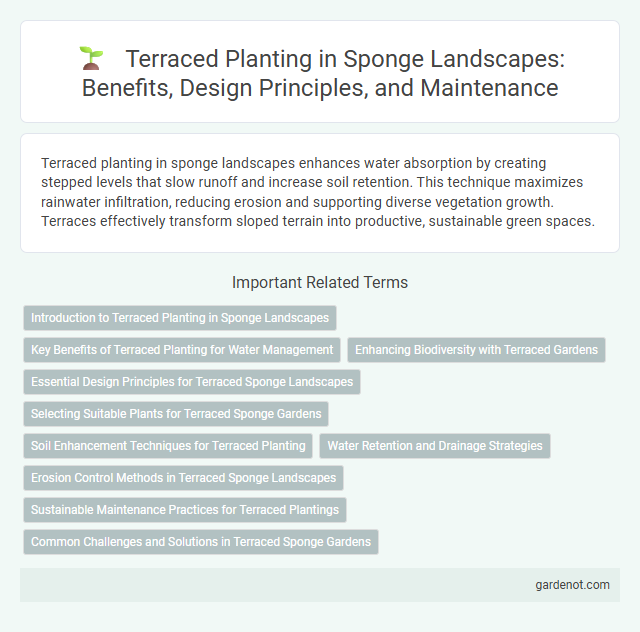Terraced planting in sponge landscapes enhances water absorption by creating stepped levels that slow runoff and increase soil retention. This technique maximizes rainwater infiltration, reducing erosion and supporting diverse vegetation growth. Terraces effectively transform sloped terrain into productive, sustainable green spaces.
Introduction to Terraced Planting in Sponge Landscapes
Terraced planting in sponge landscapes enhances water retention and reduces soil erosion by creating stepped levels that slow runoff. This method optimizes rainwater absorption, promoting vegetation growth and improving groundwater recharge. Incorporating terraced planting supports sustainable land management in areas prone to heavy rainfall and flooding.
Key Benefits of Terraced Planting for Water Management
Terraced planting significantly enhances water management by reducing surface runoff and promoting water infiltration into the soil. This technique minimizes soil erosion on slopes, preserving soil fertility and preventing nutrient loss. By capturing and distributing rainwater efficiently, terraced planting supports sustainable water use and boosts plant growth.
Enhancing Biodiversity with Terraced Gardens
Terraced planting transforms sloped landscapes into stepped gardens that support diverse plant species and create habitats for pollinators, birds, and beneficial insects. These multi-level terraces improve soil retention and water infiltration, promoting healthier ecosystems and reducing erosion. Incorporating native plants in terraced gardens further enhances local biodiversity by supporting regional wildlife and maintaining ecological balance.
Essential Design Principles for Terraced Sponge Landscapes
Terraced planting in sponge landscapes relies on essential design principles such as slope stabilization, water retention, and soil conservation to optimize rainwater infiltration and minimize erosion. Incorporating contour-based terraces with native, deep-rooted vegetation enhances permeability and supports the sponge effect by allowing gradual water absorption. Strategic layering and proper drainage management ensure sustainable moisture distribution, fostering resilient and functional terraced sponge landscapes.
Selecting Suitable Plants for Terraced Sponge Gardens
Selecting drought-tolerant and deep-rooted plants is essential for terraced sponge gardens to enhance water retention and prevent soil erosion. Native grasses, succulents, and groundcovers such as sedum, lavender, and creeping thyme thrive in terraced landscapes due to their adaptability to varying moisture levels. Proper plant selection optimizes the sponge effect by maximizing infiltration and storage of rainwater within the garden terraces.
Soil Enhancement Techniques for Terraced Planting
Terraced planting improves soil retention and nutrient availability by incorporating organic matter such as compost and mulch to enhance soil structure and fertility. Techniques like contour trenching and cover cropping reduce erosion and increase water infiltration on terraced slopes. Biochar application further boosts soil microbial activity and carbon sequestration, promoting healthier plant growth in sponge landscapes.
Water Retention and Drainage Strategies
Terraced planting enhances water retention by creating level planting areas that slow runoff and increase soil absorption, minimizing erosion on sloped landscapes. Strategic contour alignment and layered soil composition optimize drainage, directing excess water away from plant roots while maintaining adequate moisture levels. This method supports sustainable water management by balancing retention and drainage, crucial for maintaining healthy vegetation in sponge landscapes.
Erosion Control Methods in Terraced Sponge Landscapes
Terraced planting in sponge landscapes employs erosion control methods such as contour bunding, mulching, and vegetation cover to stabilize soil and reduce surface runoff. Strategic construction of terraces slows water flow, allowing greater infiltration and minimizing soil displacement on slopes. Integrating deep-rooted plants further enhances slope stability by reinforcing soil structure and preventing erosion in terraced sponge landscapes.
Sustainable Maintenance Practices for Terraced Plantings
Terraced planting in sponge landscapes enhances water retention and reduces soil erosion through careful contouring and native vegetation selection. Sustainable maintenance practices include mulching to preserve soil moisture, periodic inspection of terrace stability, and minimal use of chemical fertilizers to support biodiversity. Integrating rainwater harvesting systems further optimizes irrigation efficiency and promotes long-term ecological balance.
Common Challenges and Solutions in Terraced Sponge Gardens
Terraced planting in sponge landscapes often faces challenges like soil erosion, water runoff, and nutrient depletion due to sloped terrain. Implementing contour barriers, mulching, and selecting deep-rooted native plants can effectively reduce erosion and improve water retention. Regular maintenance and adaptive irrigation strategies ensure sustainable growth and healthier sponge garden ecosystems.
Terraced planting Infographic

 gardenot.com
gardenot.com